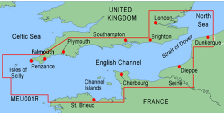


University of Southampton 2015©


Definitions
Stratification - A system or formation of layers.
Algal bloom - A rapid increase in the density of algae in an aquatic system.
Contamination - Higher concentration than normal of a substance in the environment.
Pollution - The presence or introduction into the environment of a substance which has harmful or poisonous effects.

Falmouth lies on the coast of the western English Channel (see Figure 2); a recent sea in geographical timescales, only forming between around 400,000 to 180,000 years ago, after being flooded due to rising sea levels in the last ice age melting events[1]. Average depth ranges from 150m at the westerly reaches around the Isles of Scilly, to 45m as you move eastward.
Average surface water temperatures in the English Channel range from 7°C to 16°C, resulting in a seasonally stratified water column, with stratification and temperatures peaking in September. This seasonal variation in environmental parameters influences marine algae: There are 2 main algal blooms in the costal water off Falmouth; one bloom occurring in spring and the other in August[2].
A variety of nutrients are discharged into the ocean from the river Fal, spreading from the estuary mouth into the open ocean. A history of mining for heavy metals in the area has resulted in multiple contamination events and is potentially a source of heavy metal pollution to the surrounding open water. This has been detected in elevated levels in the estuarine sediments, and due to discharge from the estuary, this is likely to also to have given rise to large amounts of toxic metals in local coastal water[3].
Common sightings of biota in offshore Falmouth consists of cetaceans, such as the common dolphin (Delphinus delphis), sunfish (Mola mola), barrel jellyfish (Rhizostoma pulmo), which are currently in bloom, and species of elasmobranch, such as the basking shark (Cetorhinus maximus).

Figure 2 - The position of Falmouth in relation to the English Channel [4]

References
[1] Hogan, C., English Channel (2013)[Online]
Available: http://www.eoearth.org/view/article/51cbedba7896bb431f693770
[Accessed
26 06 2015].
[2] Sanjeev, G., Collier, J. S., Felgate, A. & Potter, G. (2007) Catastrophic flooding origin of shelf valley systems in the English Channel. Nature, 448, pp. 342-345
[3] Brian, G.W. & Gibbs, P.E. (1983) Heavy metals in the Fal estuary, Cornwall: A study of long term contamination by mining waste and its effects on estuarine organisms, Marine Biological Association of the United Kingdom (2) 112p
[4] [Online] Available: www.electricbluefishing.com/eb_sub_menu/shipwrecks_english_ channel.htm [Accessed: 2015, June 26th]
